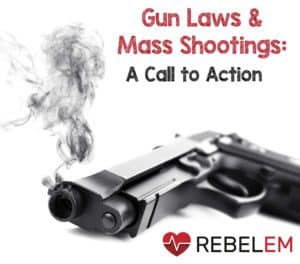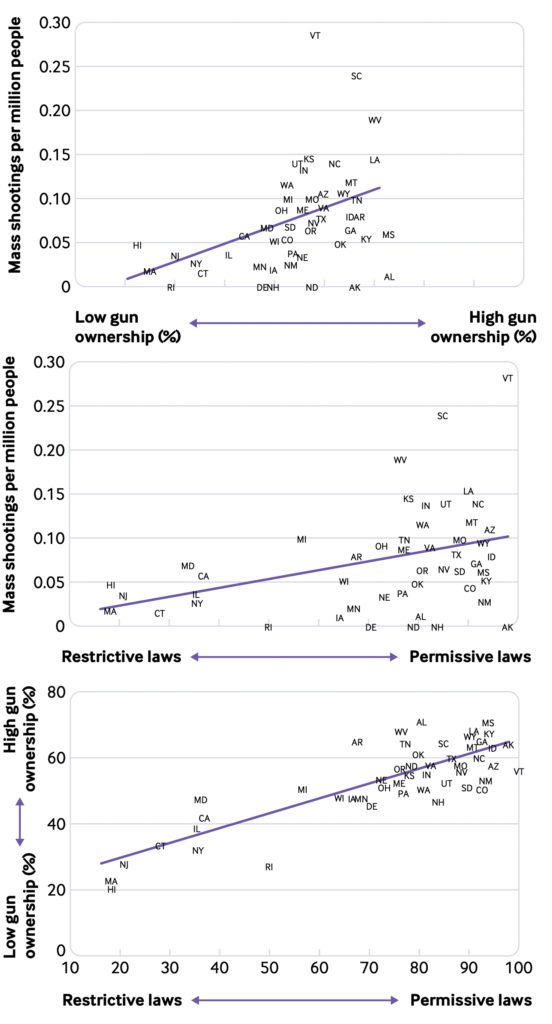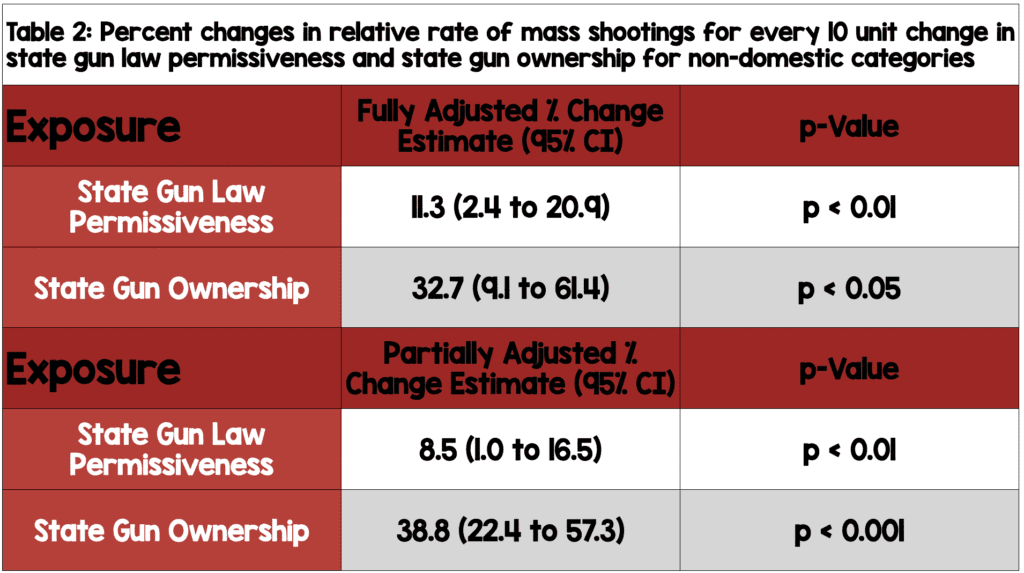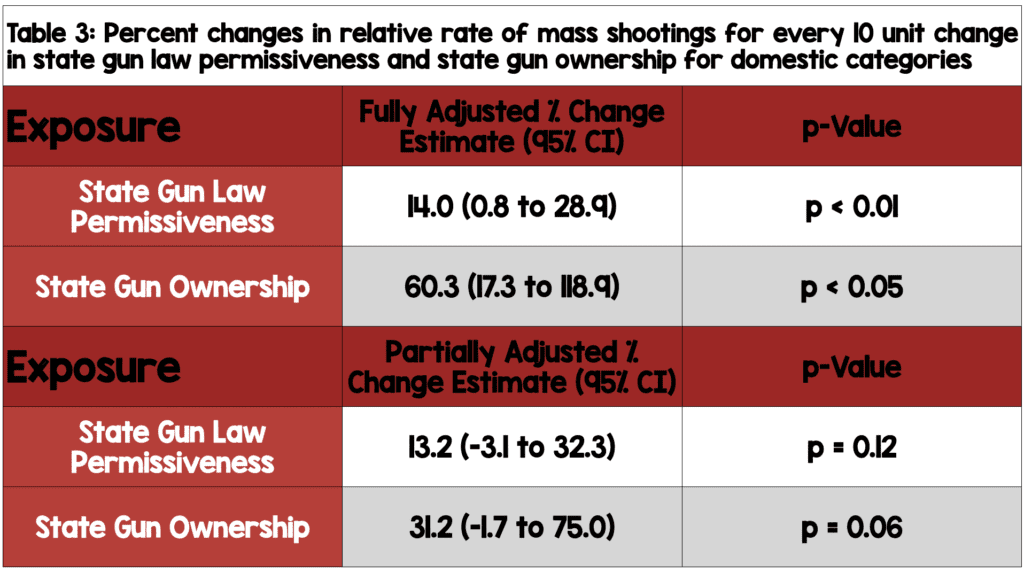

Background: Rob Elementary. Columbine. Sandy Hook. Pulse Night Club. Tops Grocery Store. Irvine Taiwanese Presbyterian Church. Virginia Beach. The Tree of Life Synagogue. Santa Fe High School. The New York City Subway. The Las Vegas Harvest Music Festival. Aurora Movie Theater. The El Paso Walmart. Tulsa. The list goes on.
The United States has a unique epidemic: mass shootings. There is no universal definition of a mass shooting but it is often referred to as an event where greater than four individuals are killed by a single perpetrator(Everytown Research & Policy, 2022). Outside of the US, mass shootings are rare events (Bloomberg 2022, Snopes 2018).
In the United States, we continue to have an average of 19 mass shootings per year (Everytown Research & Policy, 2022). Medical providers, especially Emergency Physicians, bear witness to the toll of mass shootings as we sit on the interface between the community and the hospital. As a result, it is important for us to understand the role of public policy in this epidemic.
Clinical Question: Do states with permissive gun laws have more mass shootings than states with restrictive gun laws?
Article: Reeping PM et al. State gun laws, gun ownership, and mass shootings in the US: cross sectional time series BMJ 2019. PMID: 30842105
What They Did:
- Cross-sectional time series across the 50 states of the United States of America
-
Researchers used the 1998-2015 edition of the Traveler’s Guide to the Firearms Laws of the Fifty States to obtain the annual restrictiveness-permissiveness score of US gun laws for each state.
- Annually published reference guide for gun owners concerning firearm laws of all 50 states.
- States rated from 0 (completely restrictive) and 100 (completely permissive)
-
There are several factors in developing the score:
- Standard firearms ownership and permit requirements
- If semi-automatic, high-capacity magazines, machine guns, and suppressors are permitted or restricted
- If the firearms laws across the state vary widely
- If the state employs a right to self-defense, ability to conceal, ability to open and vehicle carry
- The ability to conceal carry in state parks
- If a gun permittee can carry in a restaurant serving alcohol
- If there is a duty to notify law enforcement of permit status
- If one can keep a gun in their vehicle at colleges and K-12 schools (primary and secondary schools).
-
Gun ownership calculated via percentage of suicides committed with a firearm
- The percentage of suicides committed with a firearm provides the best estimate for gun ownership by state (Kleck 2004)
-
The researchers used the Supplementary Homicide Reports from the Federal Bureau of Investigation’s Uniform Crime Reporting System (1998-2015) to obtain counts of mass shootings by state.
- Mass shootings: one event where ≥ 4 individuals were killed by a perpetrator using a firearm
-
States stratified by restrictiveness-permissiveness scores
- Restrictive states had scores ≤50
- Permissive states had scores >50
-
Mass shooting events stratified as domestic or non-domestic
- Domestic: perpetrator committed the act against an immediate family member or partner
- Non-domestic: all other types of relationships
Population:
- Inclusions: 49/50 states (except Florida)
- Exclusions: Florida was excluded due to non-participation in the Uniform Crime Reporting System program
Outcomes:
- Primary outcome: Annual number of events and rates of mass shootings in each state
-
Secondary outcomes: Mass shooting events and rates were then stratified into:
- Domestic events: act against an immediate family member or partner
- Non-domestic events: all other types of relationships
Results:
- Bottom Line: Restrictive states, on average, had lower rates of mass shootings compared with permissive states across the board
- From 1998-2014, there were 344 mass shootings incidents reported by the Uniform Crime Reports
- 263 (76.5%) of these events were classified as non-domestic events, the remaining 81 (23.5%) were classified as domestic events
-
Critical Results:
- The average restrictiveness-permissiveness score of state gun laws showed an overall shift toward permissiveness from 1998-2014
- For each additional year that passed, scores on average became more permissive by 0.16 units (P=0.005)
-
There are positive and significant correlations between:
- Gun ownership and rates of mass shootings (Pearson’s r 0.42, P=0.003)
- Gun law restrictiveness-permissiveness and rates of mass shootings (Pearson’s r 0.38, P=0.007)
- Gun law restrictiveness-permissiveness and gun ownership (Pearson’s r 0.79, P<0.001)

-
PRIMARY OUTCOME (Table 1)
- In the partially adjusted models, an indicator variable for year was included, in addition to median income, which changed the relationship between restrictiveness-permissiveness/gun ownership and mass shootings by > 10%
- For state gun ownership, no covariate changed the relation by more than 5%, so only year was included

- SECONDARY OUTCOME (Tables 2 and 3)


Strengths:
- The associations between state gun laws, gun ownership, and mass shootings are similar to results of previous research for other types of gun injuries, indicating good reproducibility of results
- Neither the gun owners nor the public were involved in the study, limiting bias
- Researchers had no ties to any pro- or anti-gun groups, limiting bias
- Data was obtained from a public, governmental, non-partisan database
-
The state restrictiveness-permissive score used was determined by legal professionals for use by gun owners, with almost two decades of consistent data
- The score is also highly correlated with other similar state-level scales that had been previously used (r=0.85)
Limitations:
- The study design incorporated a time series component, lagged variables, and multiple covariate adjustment strategies
- There is no universal definition of mass shooting, meaning the data may be over or under-represented
- Some states fail to consistently report to the Uniform Crime Reporting System Supplemental Homicide, resulting in under-reporting of gun violence and mass shootings
-
The state restrictiveness-permissiveness score used has not been validated
- Also, models were only adjusted for covariables that changed the relationship between restrictiveness-permissiveness/gun ownership and mass shootings by greater than 10%
- It is unclear why the researchers chose 10% as their cut-off
- Gun ownership numbers were estimated using state suicide by firearm numbers (established and verified as best method as total number of guns in a state are not directly surveyed)
- Dichotomized restrictive vs non-restrictive instead of looking at it as a spectrum which is more realistic.
- Does not take into account the permissiveness of neighboring states which can influence mass shooting numbers as gun traffic from nearby states can be a major issue
Discussion:
-
Cross-Sectional Studies:
- This is a cross-sectional study, and can only find a correlation between gun law permissiveness-restrictiveness/gun ownership and mass shootings.
- However, observational data is the best and most ethical data we have surrounding mass shootings, gun law permissiveness-restrictiveness, and gun ownership.
- Cross-sectional studies can describe populations and help to delineate why mass shootings are unique to the United States.
-
Bias:
- While the investigators attempted to account for multiple variables which could have been pertinent to mass shootings, it’s possible they missed some and did not account for all related factors.
- Some states fail to consistently report gun violence to the national databases which may lead to selection bias. However, if the unreported data were randomly distributed, then under-reporting would most likely cause an underestimation of the associations found.
-
Inside the Numbers:
- Despite the increase in mass shootings, gun laws, on average, continue to become more permissive
- The partially adjusted models for domestic events did not yield statistically significant results, but both models for non-domestic events did yield statistically significant results
- This means that permissiveness in gun laws is highly correlative with mass shootings in which the perpetrator is not related to his victims
-
In the partially adjusted model, a 10 unit increase in the permissiveness of state gun laws correlated with an approximately 9% higher rate of mass shootings
- While this will translate to different numbers for each state, California, which is categorized as a state with restrictive gun laws, and has two mass shootings per year, will have one more mass shooting every five years for every 10 unit increase in permissiveness
-
In the partially adjusted model, a 10% increase in gun ownership correlated with an approximately 36% higher rate of mass shootings
- California would see three to five more mass shootings every five years for every 10 unit increase in gun ownership
Author Conclusion: “States with more permissive gun laws and greater gun ownership had higher rates of mass shootings, and a growing divide appears to be emerging between restrictive and permissive states.”
Clinical Bottom Line:
This study demonstrates a correlation between gun ownership/gun law restrictiveness-permissiveness and mass shootings. With the increasing permissiveness of gun laws and the increase in mass shootings, emergency physicians must push for policy change that can ultimately save lives.
References:
- Everytown Research & Policy. 2022. Mass Shootings in America | Everytown Research & Policy. https://everytownresearch.org/maps/mass-shootings-in-america/. Accessed 27 May 2022.
- Sam C, Rupp L. Bloomberg – Gun Violence in the US Far Exceeds Levels in Other Rich Nations. Bloomberg.com. https://www.bloomberg.com/graphics/2022-us-gun-violence-world-comparison/. Published 2022. Accessed June 24, 2022.
- MacGuill D. Snopes –Does the U.S. Experience Far More School Shootings Than Any Other Country?. Snopes.com. https://www.snopes.com/fact-check/school-shootings-us-vs-world/. Published 2018. Accessed June 24, 2022.
- Kleck G. Measures of gun ownership levels for macro-level crime and violence research. J Res Crime Delinq. 2004;41:3-6. https://journals.sagepub.com/doi/abs/10.1177/0022427803256229
- Killias M. International correlations between gun ownership and rates of homicide and suicide. CMAJ. 1993;148:1721-5. [PMID: 8485675]
- Lester D. Gun control, gun ownership, and suicide prevention. Suicide Life Threat Behav. 1988;18:176-80. [PMID: 3262246]
- Lester D. Relationship between firearm availability and primary and secondary murder. Psychol Rep. 1990;67:490. [PMID: 2263699]
- Hemenway D, Miller M. Firearm availability and homicide rates across 26 high-income countries. J Trauma. 2000;49:985-8. [PMID: 11130511]
- Fleegler EW, Lee LK, Monuteaux MC, et al.. Firearm legislation and firearm-related fatalities in the United States. JAMA Intern Med. 2013;173:732-40. [PMID: 23467753]
Guest Post By:

Sarah Aly, DO
PGY-3, Emergency Medicine Resident
Saint Joseph’s University Medical Center, Paterson New Jersey
Twitter: @alyalyoxenfree_

Marco Propersi, DO FAAEM
Assistant Professor, Emergency Medicine
Saint Joseph’s University Medical Center, Paterson New Jersey
Twitter: @marco_propersi
Post-Peer Reviewed By: Anand Swaminathan, MD (Twitter: @EMSwami) and Salim R. Rezaie, MD (Twitter: @srrezaie)
The post Gun Laws and Mass Shootings: A Call to Action appeared first on REBEL EM - Emergency Medicine Blog.
